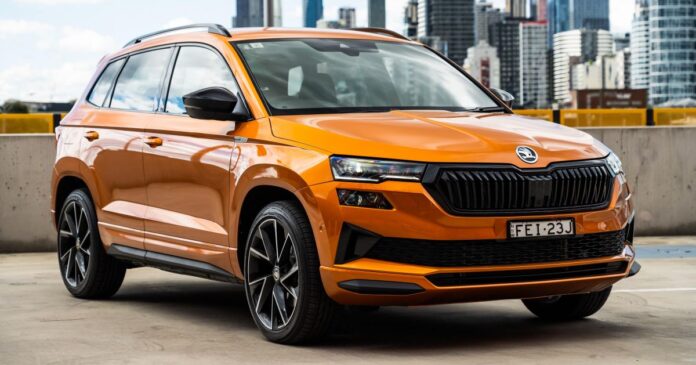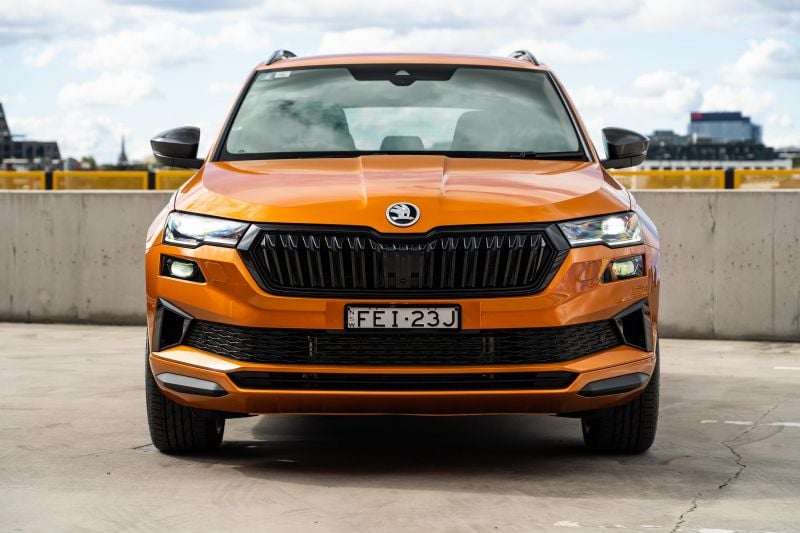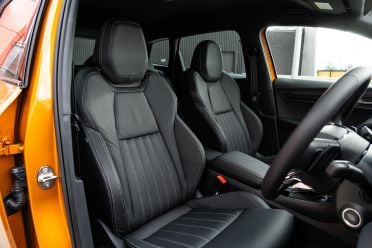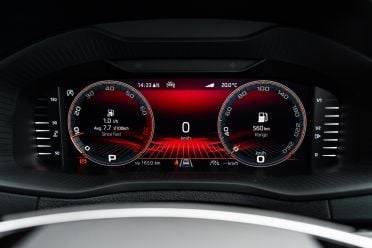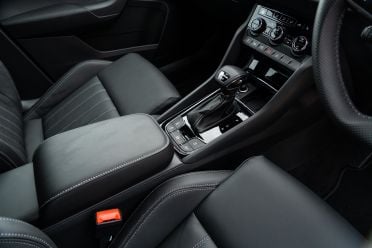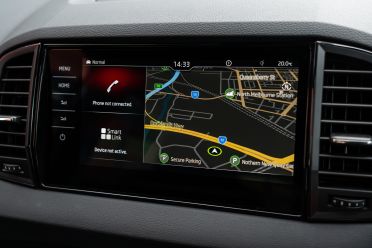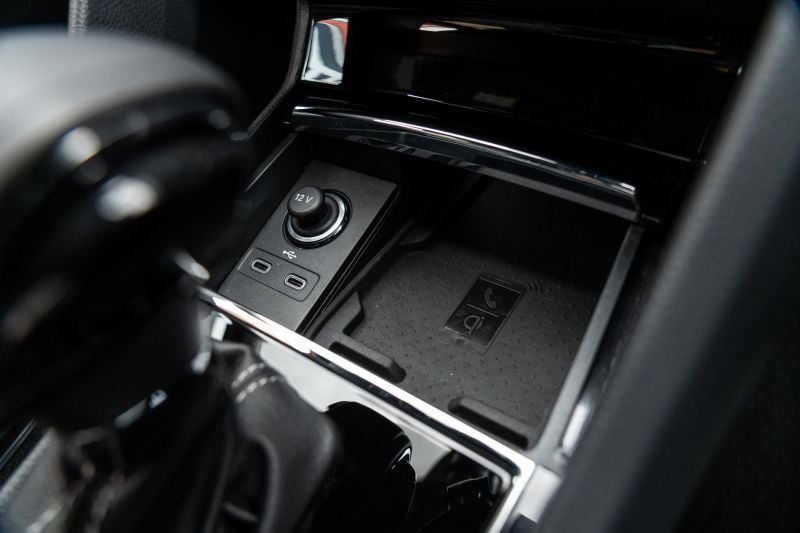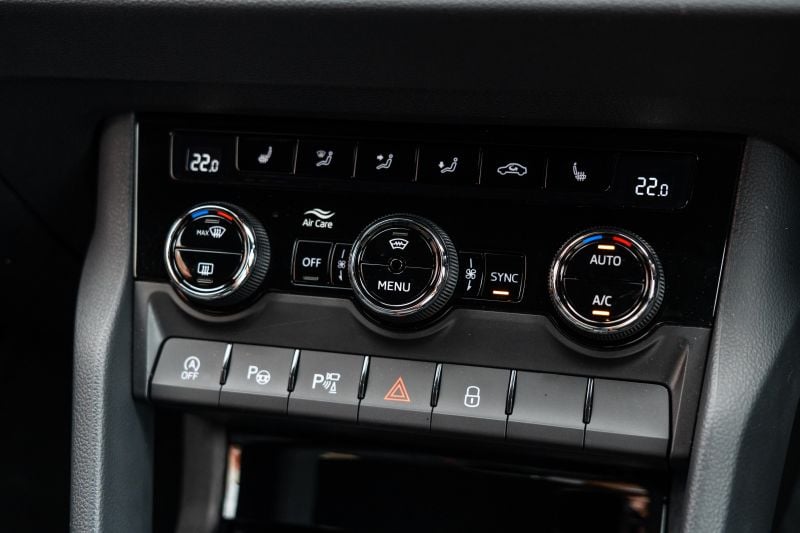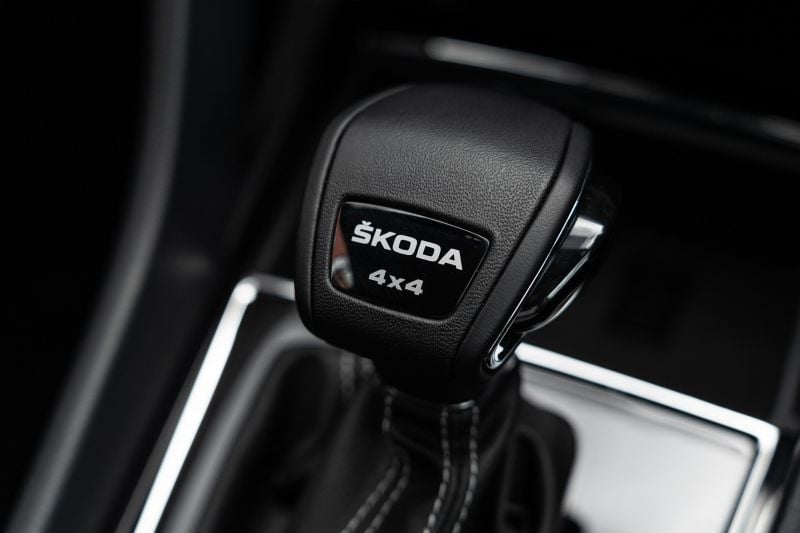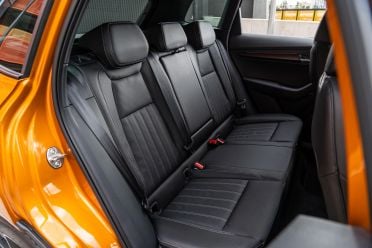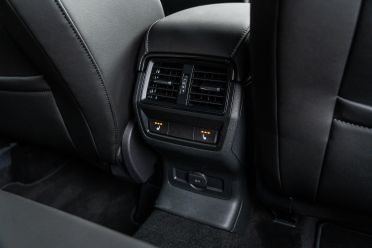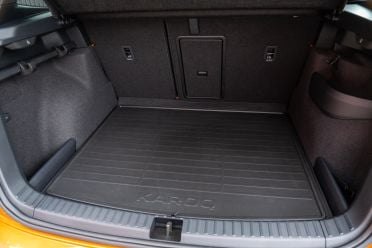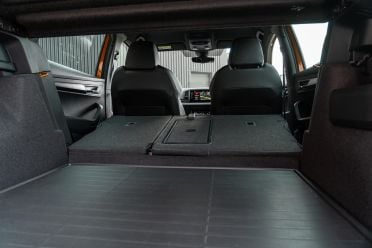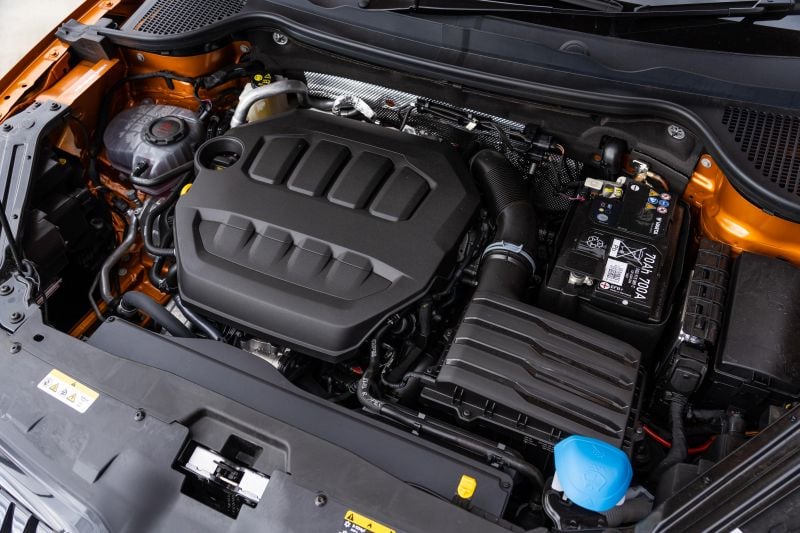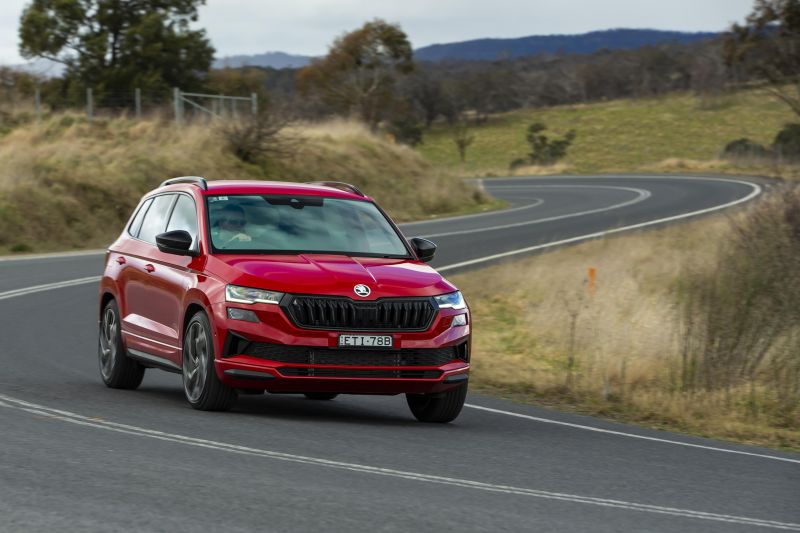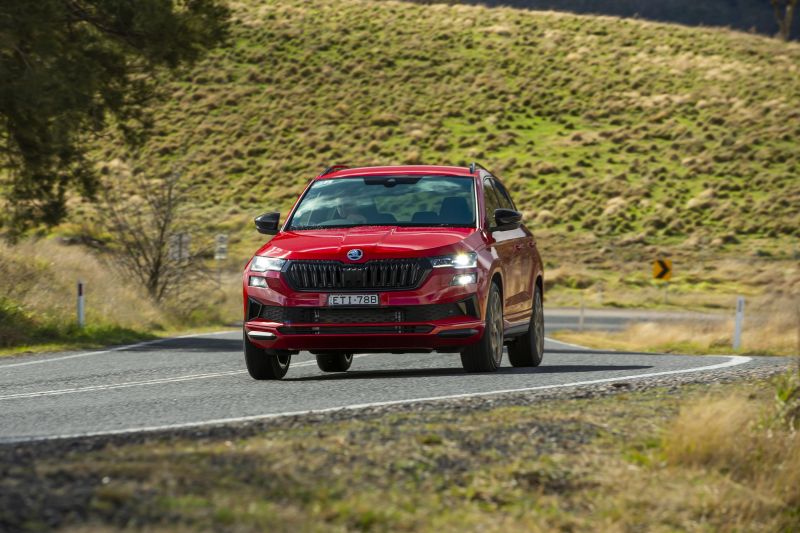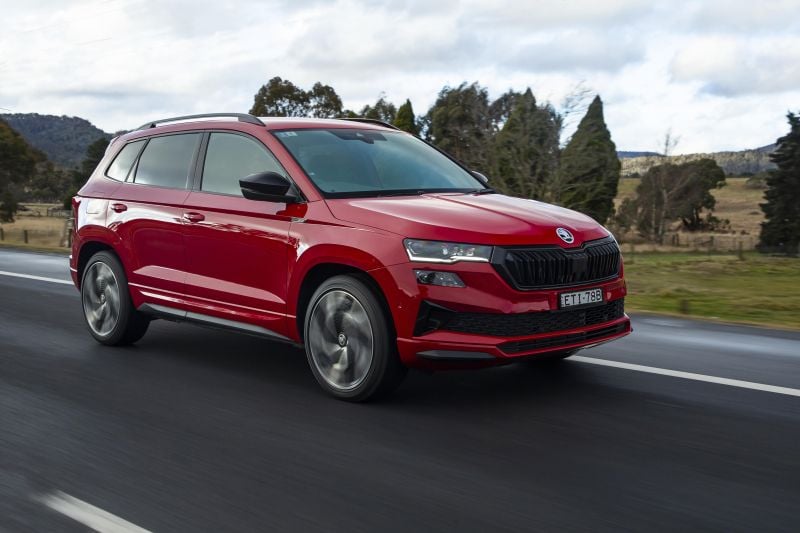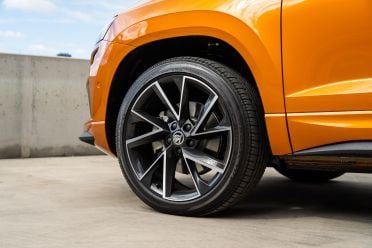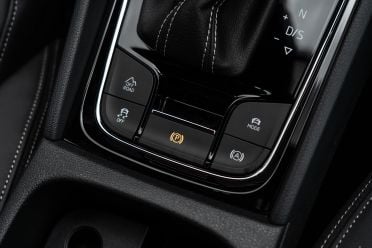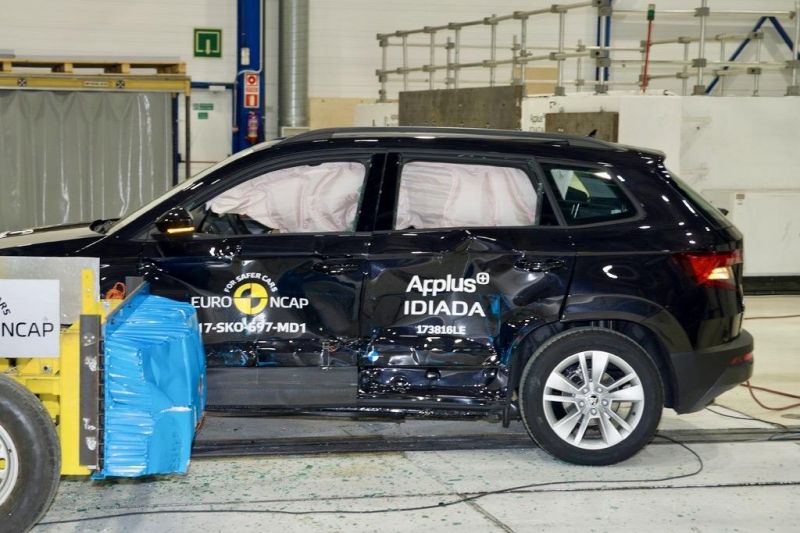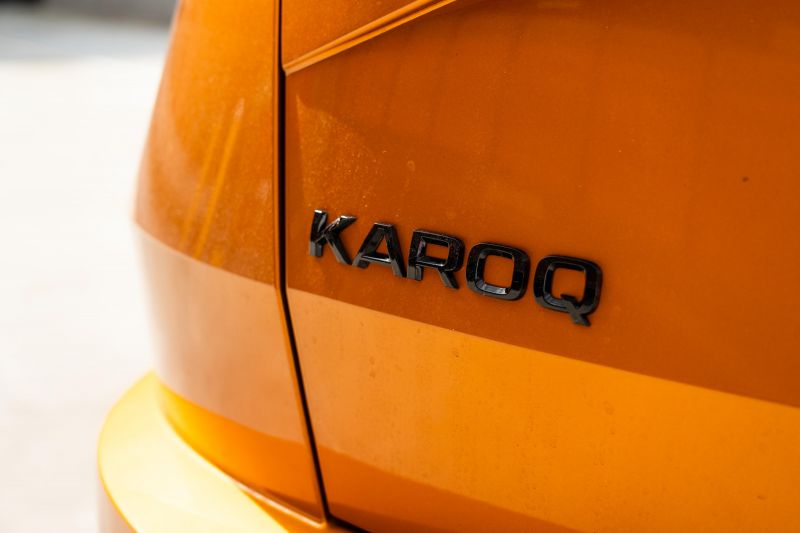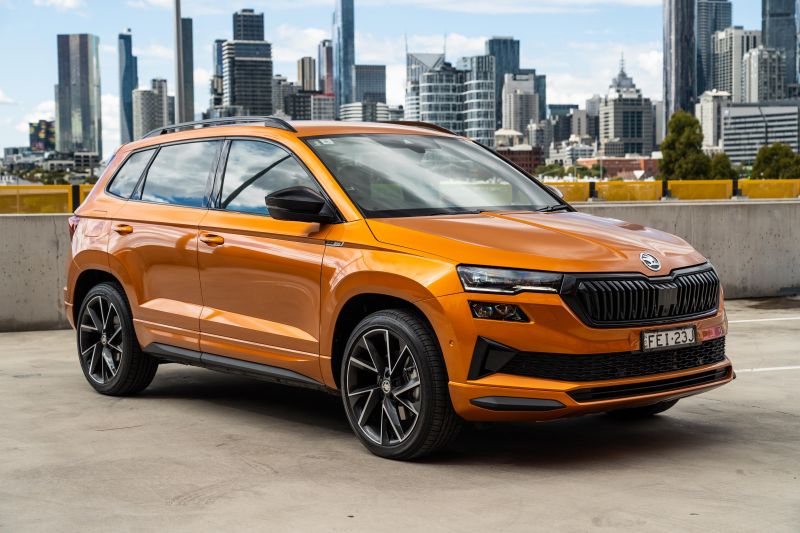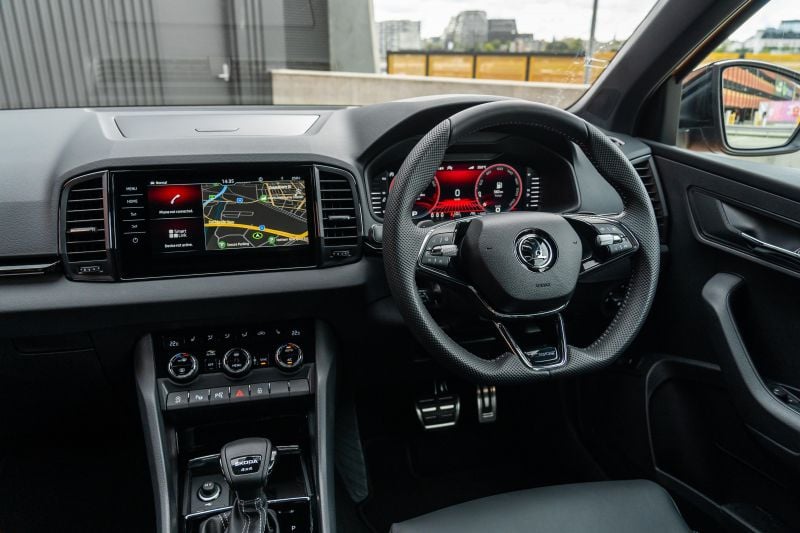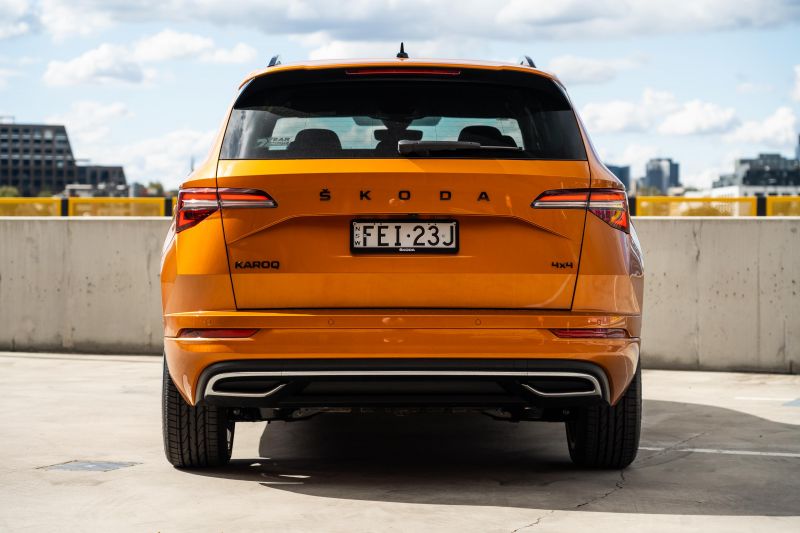The Skoda Karoq is getting on in years now. It’s one the Czech brand’s oldest models still on sale locally and it’s also currently the slowest-selling Skoda SUV.
-
MY24 Sportline 4×4 pictured throughout
This small-to-mid-sized SUV was first revealed in 2017 and received a facelift in 2021. An all-electric successor, called the Elroq, was revealed last month and is due to replace it in mid-2025.
In the meantime, however, Skoda has given the Karoq an update for the 2025 model year. Highlights include a revised lineup with new nameplates and more standard equipment, as well as higher asking prices.
On test here is a flagship Skoda Karoq Sportline 4×4 variant, though it’s technically a 2024 model year example (MY24). Subtle differences from MY25 examples include a slightly different alloy wheel design, and standard equipment that was previously only available as part of option packages.
WATCH: Paul’s video review of the 2024 Skoda Karoq
Despite the introduction of the similar-looking Sportline 4×2, this flagship variant is the only one that comes with a torquier 2.0-litre turbo-petrol engine and all-wheel drive.
How does this hold up against ever-improving competition? Read along to find out.
How does the Skoda Karoq compare?
View a detailed breakdown of the Skoda Karoq against similarly sized vehicles.

Skoda
Karoq
On test here is the flagship Karoq Sportline 4×4 fitted with optional extras.
| Model Variant | Price before on-road costs | Drive-away price |
|---|---|---|
| 2025 Skoda Karoq Select | $39,990 | $40,990 |
| 2025 Skoda Karoq Sportline 4×2 | $45,990 | $46,990 |
| 2025 Skoda Karoq Sportline 4×4 | $56,590 | $57,990 |
If you add all the optional extras on our tester, including the Phoenix orange metallic paint, the asking price comes to $62,760 drive-away. Ouch!
To see how the Skoda Karoq stacks up agains the competition, check out our comparison tool.
Hopping into the Skoda Karoq Sportline, it’s very easy to see why this type of vehicle sells in droves in Australia. You step across into the vehicle rather than having to step up or down, which is helpful for those with poor mobility.
Once you’re in, it feels like you’re sitting on a seat that’s on stilts. There’s plenty of visibility from the driver’s seat and so you’re easily able to place each corner of the vehicle. This is something that SUV buyers seek.
Our tester is fitted with the optional Signature Pack that adds a range of features like leather-appointed upholstery, power-adjustable front seats with memory, and side mirror memory. It’s a $4000 package and unless you really love leather I don’t know if I’d personally opt for it.
While the front seats are squishy and comfortable for longer journeys, I found them to be a little on the flatter side despite being a sport-oriented model. The seats in the Cupra Formentor offer more side bolstering to secure you better in bends.
The front seat’s electric adjustment allows me to get comfortable behind the wheel easily. There’s also seat position memory, which is handy if multiple people drive the car.
There are now heated front and rear outboard seats as standard. Up front, the seats get really hot – so much so that I could only tolerate the weakest level.
Like a few other Volkswagen Group SUVs, including the Tiguan, the Karoq’s accelerator and brake pedals are positioned very high. You almost have to take your heel off the floor to press the brake pedal. This isn’t world-ending and is certainly something you acclimatise to, but it’s something I noticed straight away.
Ahead of the driver is a leather-wrapped steering wheel with plenty of perforations, which may trigger you if you have trypophobia. It’s a nice unit to hold but, unlike the seats, its heating is a little on the weaker side.
The buttons and scroll wheels on the steering wheel mightn’t be to everyone’s tastes, but I personally like them. It’s satisfying being able to scroll the volume up and down, rather than having to push a button.
As standard on the Karoq Sportline 4×4, there’s a 10.25-inch digital instrument cluster, or Virtual Cockpit in Skoda-speak, which is clear to read and high-resolution.
Volkswagen Group digital instrument clusters are among the best out there right now in terms of adjustment and configurability. There are countless informative pages, widgets and layouts to choose from. It’s also nice to be able to have the satellite navigation info up on the digital instrument cluster in front of you, if you like.
Moving across to the left, the Karoq Sportline 4×4 now comes standard with a larger 9.2-inch touchscreen infotainment system. It fills the space considerably better than the smaller 8.0-inch unit and also doesn’t have that awkward power icon on the volume knob, which spins with use (if you know, you know).
While it’s nice to have the larger touchscreen, the interface and icons are starting to look quite dated in 2024. For the majority of people who use Apple CarPlay and Android Auto, however, this isn’t an issue.
Speaking of smartphone mirroring, the entire Karoq range comes with both wired and wireless forms of Apple CarPlay and Android Auto. With my iPhone 15 Pro Max connected wirelessly, it was generally good but occasionally the connection would get a little patchy.
There is a wireless phone charger but it’s tucked away at the front of the centre console and is too small to fit my plus-sized phone. Once I took my phone case off it did fit in the space but refused to charge. Thankfully, there are USB-C ports if you need to top up your phone battery.
I love how the Karoq has stuck with a climate control setup with physical dials and buttons. It’s much more intuitive than the touch-sensitive setup in the T-Roc, and lightyears better than ones integrated into the touchscreen.
One of my favourite features in the Karoq is AirCare, which is a system that’s able to vent out smells and replenish the cabin with fresh air. It’s particularly handy if you had fast food in the car, or someone lets one rip.
Looking around the cabin, there are a fair few dark finishes. It does look a little like a sea of black in our tester, but there’s still plenty of light let in by the wide windows. Opting for the optional panoramic sunroof would make it even airier.
There are some soft-touch materials in high-traffic areas like the armrests and dashboard, but you don’t need to look far to find harder surfaces. Don’t be expecting felt-lined door bins like in some other Volkswagen Group vehicles.
Something interesting about the Karoq compared to other SUVs is that it feels like everything is mounted low, especially the gear selector. Some cars typically like to have the switchgear close to the driver so they feel like they’re cocooned in a cockpit.
On the centre tunnel there’s a reversible cupholder and shelf setup that can be covered up by the armrest. This sounds handy in theory, but in practice the cupholders are awkwardly small, and there’s no proper centre cubby.
One redeeming factor about the centre console is that it comes with a ratcheting centre armrest that you can set to your desired position. More cars should have this feature.
Since the semiconductor chip shortage back in 2020, the Karoq hasn’t really been available with a premium sound system, not even as an option, which is disappointing. There’s an unbranded eight-speaker setup that performs okay, but isn’t necessarily a standout.
Hopping into the second row, the space on offer is adequate for the segment. You can easily get two adults back there in comfort, but three might be a bit of a pinch given there’s a bit of transmission hump protrusion.
At a leggy 182cm, I had enough leg, toe, head and shoulder space in the second row behind my own driving position to get comfortable. And I’d be able to travel long distances back there with no worries, as the windows are large enough to see out of.
In terms of second-row amenity, there are console-mounted rear air vents and a 12V outlet, as well as a fold-down armrest with cupholders.
Around the back there’s a powered tailgate that opens and closes quickly and silently. I’m thankful there are no obnoxious bings and bongs when it starts opening or closing, because that’s so embarrassing.
Once the tailgate is open you really start to see where Skoda has put all its ‘Simply Clever’ touches in the Karoq. Some features to note include the reversible boot mat, storage cubbies, moveable hooks and nets to secure items.
There’s 521 litres of boot space with the rear seats up, which is plenty for the segment. Boot space also expands to 1630 litres with the rear seats folded.
Under the boot floor there’s a space-saver spare wheel, which is good to have but not as handy as a proper full-size unit. This is something to note if you frequently travel in rural or regional areas away from tyre repair shops.
| Dimensions | Skoda Karoq Sportline 4×4 |
|---|---|
| Length | 4390mm |
| Width | 1841mm |
| Height | 1612mm |
| Wheelbase | 2630mm |
| Cargo capacity | 521-1630 litres |
The Skoda Karoq Sportline 4×4 is powered by a version of VW’s widespread 2.0-litre turbocharged four-cylinder petrol engine that produces, you guessed it, 140kW of power. This engine and tune is shared with the Audi Q2 40 TFSI, Cupra Formentor V, Cupra Ateca V, and Volkswagen T-Roc R-Line.
| Model | Skoda Karoq Sportline 4×4 |
|---|---|
| Engine | 2.0L 4cyl turbo |
| Power | 140kW @ 6000rpm |
| Engine torque | 320Nm @ 1500-4100rpm |
| Transmission | 7-speed DCT |
| Driven wheels | All-wheel drive |
| Weight | 1665kg (tare) |
| Fuel economy – claim | 6.6L/100km |
| Fuel economy – as tested | 7.5L/100km |
| Fuel tank size | 55 litres |
| CO2 emissions – claim | 152g/km |
| Emissions standard | Euro 6 |
| Fuel requirement | 95 RON |
To see how the Skoda Karoq stacks up agains the competition, check out our comparison tool.
When starting up the Skoda Karoq Sportline 4×4, there’s a sweet engine rev that’s very familiar if you’ve driven a Volkswagen vehicle before. For me it feels like home.
-
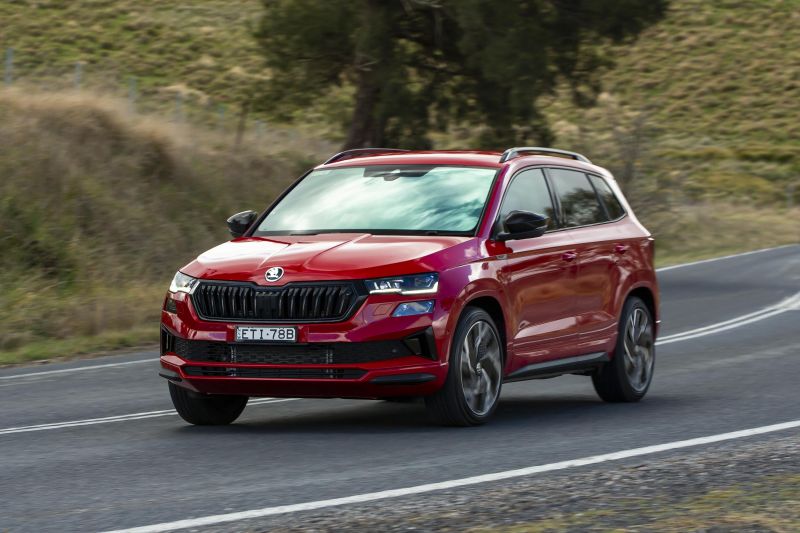
MY22 Karoq Sportline 4×4 shown
The engine idles high for just a bit when it’s cold, but doesn’t take very long to settle down because it warms up quickly. You can tell this vehicle is equipped for cold climates.
Once you get moving, power from the 2.0-litre turbo-petrol four is sufficient and smile-inducing. With 140kW of power and 320Nm of torque, it’s almost warm leaning. Don’t go expecting the Karoq Sportline to be as hot as the T-Roc R, however.
The seven-speed dual-clutch automatic is generally good, but you do have to learn how to drive with it, which is a common trait of vehicles with this type of transmission compared ones equipped with a torque converter or CVT auto.
The car can occasionally be a little hesitant when taking off, but if you allow it time to sort itself out, say by pre-empting the green light, you’ll be fine. With this in mind, other cars may beat you off the mark from the traffic lights unless you gun it, so you need to drive assertively if that matters to you.
Once you’re moving, the Karoq’s beauty of an engine and transmission combo comes into its own. In everyday scenarios, the dual-clutch gearbox likes to switch up to second gear as soon as possible. The car can sometimes even start in second gear if you’ve almost come to a stop and set off again.
Part of the reason for this is that there’s oodles of torque from the turbo-petrol engine. It makes for an effortless driving experience in which you can lean into the strong torque delivery from low down in the rev range. Peak torque comes on tap from 1500rpm.
The dual-clutch auto will change up gears as quickly as possible to keep the revs down and minimise fuel consumption. Thanks again to the meaty amount of torque, the transmission will hold gears for as long as possible before downshifting, only selecting a lower gear if you floor it or meet a steeper hill.
Around town, the Karoq’s steering is on the lighter side, which makes manoeuvring in tight laneways and carparks a breeze. Parking is also easy-peasy.
As standard, the Karoq Sportline comes with front and rear parking sensors, as well as a surround-view camera. The latter has a disappointingly poor quality display.
There’s also a Park Assist feature, but it’s not very handy as it can’t park the car between marked lines and instead requires two cars to work properly. It’s much easier to park it yourself.
Even at lower speeds there’s pronounced tyre roar inside the cabin. This isn’t uncommon for European vehicles on rough and coarse-chip Australian road surfaces. The roar gets louder once you get out on the open road.
Unlike the rest of the Karoq range, the Sportline 4×4 receives a more sophisticated independent multi-link rear suspension setup instead of a live torsion beam arrangement. This helps make the ride more compliant, though typically it still errs on the sportier side of comfortable.
The car also gets Dynamic Chassis Control (DCC), which is essentially Skoda-speak for adaptive dampers. There are a range of different drive modes that adjust how the shock absorbers react to bumps.
Comfort mode softens things out to the point where you almost feel like you’re floating on a cloud, whereas Sport mode firms things up and transmits more road imperfections through to the cabin. For pretty much all my everyday driving, I stuck with the Normal driving mode because I found it struck a nice balance between overall comfort and dynamics.
Regardless of the drive mode, however, you can still feel a sense of sportiness through the suspension. There are also some road jitters at higher speeds, even in Comfort mode.
Building up speed in the Karoq Sportline is easy and stress-free. You can also slot the car into Sport mode if you like and it becomes a little pocket rocket, feeling properly warm. In general, there’s enough oomph in the tank to easily perform overtakes if necessary.
The Sportline is the only Karoq variant to offer all-wheel drive, which gives you an added sense of security in slippery situations. But for the majority of driving on sealed surfaces, or even gravel tracks, you likely won’t really feel any tangible difference in terms of grip compared to its front-drive siblings.
There is an off-road mode if you’re keen on taking your warm European SUV with 19-inch alloy wheels off the beaten track, but I doubt the average owner would really use it.
On the safety front, the adaptive cruise control system is fantastic and very natural in terms of its operation. Unlike a lot of cars that now have these functions integrated on the steering wheel, you set and adjust the cruise control parameters on a stalk.
This isn’t necessarily a good or bad thing, it’s just something that took a little while for me to adjust back to. My family’s 1998 Mitsubishi Magna has cruise control on a stalk, for example.
Something I didn’t get used to, however, was the annoying feature that doesn’t let you undertake a car with adaptive cruise control set. This is a common feature in Volkswagen Group vehicles and is frustrating in Australia where lane etiquette isn’t the sharpest.
The lane-keep assist is nice to have but, like some systems, I found it to be a little overactive and wanting to rip the steering wheel out of my hands if I drifted a little too closely to the lane markings.
On the other hand, the Travel Assist system, which is once again part of the Premium Pack, works fantastically with the adaptive cruise control system to make long drives on highways and freeways less tiring.
Lastly, the Karoq Sportline comes standard with matrix LED headlights. These are great if you frequently drive in the country as you can keep your high beams on for as long as possible and the car will automatically dip certain parts of the headlight when it detects a car’s headlights or tail-lights.
On test here is the flagship Karoq Sportline 4×4 fitted with pretty much every optional extra, apart from the panoramic glass sunroof and side steps.
Karoq Select highlights:
- 18-inch alloy wheels
- Silver roof rails and window frame surround
- LED headlights and tail-lights
- Automatic high-beam
- Dynamic indicators
- Power-folding and heated mirrors
- Rain-sensing wipers
- Leather-trimmed steering wheel
- Manually height-adjustable front seats
- Auto-dimming rearview mirror
- Dual-zone climate control
- 8.25-inch digital instrument cluster
- 8.0-inch infotainment touchscreen
- Wireless Apple CarPlay and Android Auto
- 2x USB-C ports
- Voice control
- Keyless start
Karoq Sportline 4×2 adds:
- Hands-free power tailgate
- Privacy glass
- 19-inch anthracite alloy wheels
- Anthracite front spoiler and rear diffuser
- Black window frame surrounds
- Matrix LED headlights with adaptive high-beam
- LED interior lighting
- Ambient lighting
- LED puddle lamps
- Heated front and rear seats
- Heated steering wheel
- Paddle shifters
- Sports comfort front seats
- Aluminium finish pedals
- Black headliner
- 10.25-inch digital instrument cluster
- DAB+ digital radio
- Wireless smartphone charging
- USB-C port in rearview mirror
- Keyless entry
- Rear privacy glass
- Heat insulating windscreen
- Hands-free power tailgate
Karoq Sportline 4×4 adds:
- Dynamic Chassis Control (DCC) adaptive suspension
- Progressive steering
- Heated windscreen washer nozzle
- 9.2-inch infotainment touchscreen
- Satellite navigation
- 10-speaker Canton sound system
- Semi-autonomous parking assist
Skoda has made a number of features standard across the range now, but there are still some options.
Signature Pack ($4000) adds:
- Leather-appointed upholstery
- Power-adjustable front seats
- Front seat position memory
- Side mirror memroy
There’s also a panoramic glass sunroof as a standalone option for $1900, as well as side steps for $1500, but neither were fitted to our tester.
The Skoda Karoq was awarded a five-star ANCAP safety rating based on Euro NCAP tests conducted in 2017, but that’s now expired so it’s officially ‘unrated’ by the independent vehicle safety body.
Previously, however, all Karoq variants were covered by this rating, which was based on category scores of 93 per cent for adult occupant protection, 79 per cent for child occupant protection, 73 per cent for pedestrian protection, and 58 per cent for safety assist.
Standard safety equipment includes:
- Autonomous emergency braking (AEB)
- Pedestrian detection
- Cyclist detection
- Adaptive cruise control
- Lane-keep assist
- Blind-spot monitoring
- Front and rear parking sensors
- Reversing camera
- Manoeuvre braking assist
- Multi-collision brake
- Tyre pressure monitoring
- Advanced driver fatigue detection
Stepping up to the Sportline 4×2 adds traffic jam assist, lane centring and emergency assist, while the Sportline 4×4 now includes a surround-view camera and hill-descent control.
The Karoq is covered by a seven-year, unlimited-kilometre warranty.
| Ownership Program | Skoda Karoq Sportline 4×4 |
|---|---|
| Warranty | 7 years, unlimited kilometres 7 years, unlimited kilometres (engine starting batteries) 2 years, unlimited kilometres (genuine parts and accessories) 3 years, unlimited kilometres (paint) 12 years, unlimited kilometres (corrosion) |
| Roadside assistance | 1 year |
| Service interval | 12 months, 15,000km |
| Servicing pricing | $2450 (5-year pre-paid service pack) $2750 (7-year pre-paid service pack) |
The Skoda Karoq is a car that deserves to sell better than it does because it’s in a very popular market segment in Australia.
It has plenty of storage space for a small-to-medium SUV and there are heaps of ‘Simply Clever’ touches Skoda has added to make the Karoq feel unique and special.
A sticking point, however, is that there are too many direct rivals from the Volkswagen Group with the same powertrain combination at a similar price point.
Sure, Skoda has drive-away pricing for the Karoq, which on the surface makes it seem more affordable, and there is now more standard equipment, but there are still certain things limited to option packages.
With all the option boxes ticked, this car is costs well over $60,000 drive-away, which is pushing it into the territory of hotter but less practical crossovers.
For a similar price you can get into a Cupra Formentor VZ, which admittedly doesn’t have all-wheel drive, but does offer more power and more innately sporty dynamics.
The full-fat Volkswagen T-Roc R also costs only a bit more than our fully optioned tester here.
Pricing aside, the Karoq Sportline is fundamentally a great and dynamic package. The extra standard equipment is well received, though if you require all-wheel drive, the sweet spot is lower down in the range.
Interested in buying a Skoda Karoq? Get in touch with one of CarExpert’s trusted dealers here
Click the images for the full gallery
MORE: Everything Skoda Karoq

